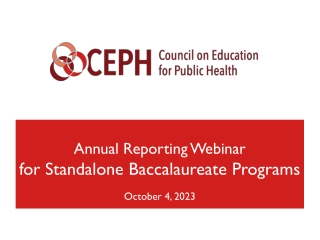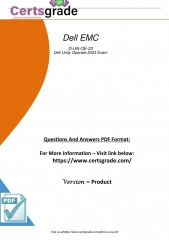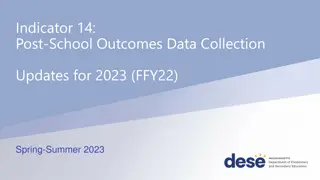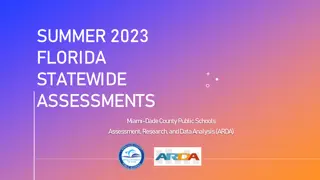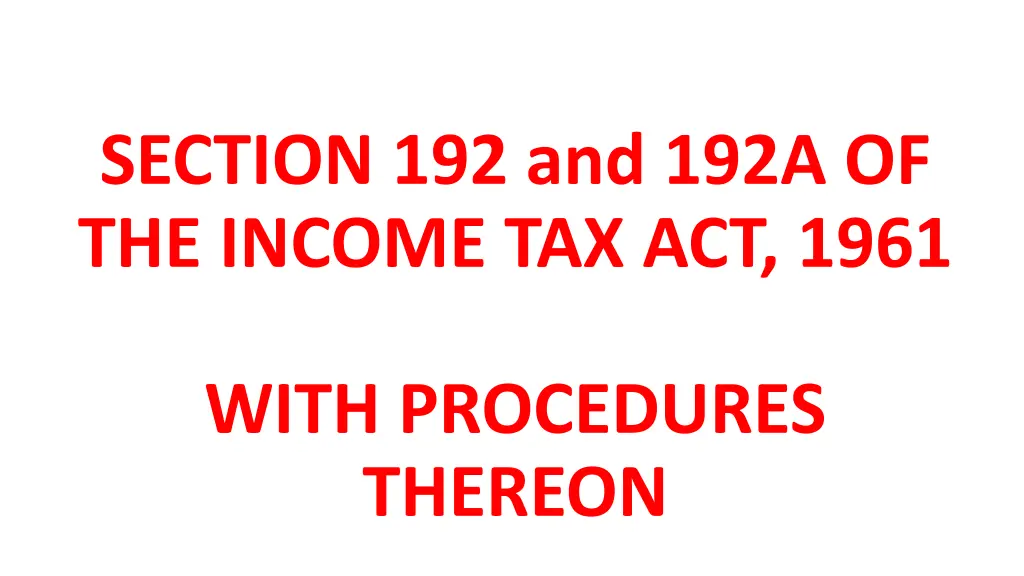
Understanding Section 192 and 192A of Income Tax Act 1961
Explore the detailed provisions of Section 192 and 192A of the Income Tax Act, 1961, which focus on Tax Deducted at Source (TDS), rates, responsibilities, and procedures related to salary payments and Provident Fund schemes. Learn about when TDS should be deducted, rates applicable, and the entities responsible for deduction. Stay informed on income tax regulations for smooth compliance.
Download Presentation

Please find below an Image/Link to download the presentation.
The content on the website is provided AS IS for your information and personal use only. It may not be sold, licensed, or shared on other websites without obtaining consent from the author. If you encounter any issues during the download, it is possible that the publisher has removed the file from their server.
You are allowed to download the files provided on this website for personal or commercial use, subject to the condition that they are used lawfully. All files are the property of their respective owners.
The content on the website is provided AS IS for your information and personal use only. It may not be sold, licensed, or shared on other websites without obtaining consent from the author.
E N D
Presentation Transcript
SECTION 192 and 192A OF THE INCOME TAX ACT, 1961 WITH PROCEDURES THEREON
INDEX INDEX Introduction Definition Features and Brief overview Sections and Rules Transaction with applicable rate Procedure and Proceedings Duties & Responsibilities Examples Relevant Case Laws Conclusion
Introduction Introduction TDS: TAX DEDUCTED AT SOURCE :- In order to safeguard the government revenue and also to receive Tax in regular manner the Central Government has fixed a mechanism as suggested and implemented inspite of payment of tax after self assessment or after fixation of estimated income by the assesse to deduct tax by the payer at the time of generation of Income or credit of Income in favour of the beneficiary. Definition :- Income : Section 2(24): Chapter XVII
Tax Deducted at Source (TDS) Rate Chart/Slab for Financial Year Tax Deducted at Source (TDS) Rate Chart/Slab for Financial Year 2019 20 relating to the Assessment 20 relating to the Assessment Year 2019- - Year 2020 2020 - -21 till March 2019 21 till March 2019 Section Nature of income When to deduct Rate of TDS 192 Salary Monthly- at the time of payment where estimated yearly net taxable salary exceeds tax free limit. On the average rates on the basis of per rates for individuals. (30% if no Valid PAN) 192A Payment of accumulated balance due of Employees Provident Fund Scheme, 1952, to Employess which is taxable in their hand (w.e.f 01-06-15) when the amount of payment or aggregate amount of payment exceeds Rs. Rs. 50,000/- 10% (30% if no Valid PAN) 193 (See note-1 )* Interest on securities* a) any debentures or securities for money issued by or on behalf of any local authority or a corporation established by a Central, Stateor Provincial Act; b) any debentures issued by a company where such debentures are listed on a recognised stock exchange in accordance with the Securities Contracts (Regulation) Act, 1956 (42 of 1956) and any rules made thereunder; c) any security of the Central or StateGovernment; d) intereston any other security At the time of credit or payment, whichever is earlier, when the amount exceeds Rs. 10,000/-In case of Debentures Threshold limit is Rs. 5000/- 10% (20% if no Valid PAN)
Person responsible to deduct tax under section192 Person responsible to deduct tax under section192 Every person irrespective of the fact that whether Individual, HUF, Firm, LLP, Company, AOP, Body of Individual, Society, Co-Operative Society and Artificial Juridical Person as defined U/s 2(31) of the Act whether incorporated or not paying salary income is required to compute the estimate of the income chargeable under the head Salaries . The value of the perquisites as provided by the employers to its employees and any obligation payment thereof shall be determined under rule 3 and shall be taken in to account while estimating income under the head Salaries . Further, any income falling under section 10 (income which do not form part of total income) shall not be included in computing the income from salaries for the purpose of section 192 of the Act. The person responsible for making payments shall also take into consideration amount deductible under section 24b or any set off of loss whether applicable under section 70-72 and also deduction under Chapter VIA such as 80C, 80CCC, 80CCD, 80CCG, 80D, 80DD, 80DDB, 80E, 80EE, 80G, 80GG, 80GGA, 80TTA and 80U. Section 192(2A) provides that deduction of tax at source is to be made after allowing relief u/s 89(1) and after considering the tax on perquisites agreed to be borne by employer. Section 192(2D) further casts responsibility on the person responsible for paying any income chargeable under the head Salaries to obtain from the assessee (employee), the evidence or proof or particulars of prescribed claims which includes any claim for set-off of loss under the provisions of the Act in the prescribed form and manner for the purposes of
a) estimating income of the assessee (employee); or b) computing tax deductible under section 192(1). Section 192(2) provides that where an assessee is employed under more than one employer, then the assessee (employee) may choose the employer for deduction of tax at source. Thereupon, that employer shall deduct tax at source from the aggregate salary of an employee. For this purpose, employee is required to furnish details of salary due or received by him from other employer(s) in Form No. 12B to one of the employers (as chosen by him). As per the provision of section 192(3), the person responsible for paying the salary may, at the time of deducting tax at source, increase or reduce the amount to be deducted for the purpose of adjusting any excess or deficiency arising out of previous deduction or non-deduction. The employee may provide to the employer, particulars of: i) Other Income, including tax deducted thereon ii) Loss only if it is under the head of Income from House Property
Income from House Property implies:- Any other rental income may be informed to the employer Deemed let out property- From A.Y. 2020-21, if assessee owns more than two self occupied residential houses, such other house or houses shall be deemed to have been let out and its annual value shall be computed in accordance with Section 23(1) from the A.Y. 2020-21 and upto A.Y. 2019-20 if the assessee owned two houses, the other house had to be deemed to have been let out. Assessee can claim deduction of interest paid on borrowed capital u/s 24(b) of the Act Loss only under the head Income from House Property can be informed to the employer House Property loss can be set-off maximum upto Rs. 2 Lakhs. [Section 71(3A)] Particulars of Other Income to be informed to the employer in simple statement duly verified by the employee- Rule 26B In case if the employee furnishes to his employer, the details regarding his other incomes, investments, eligible deductions etc., then for the purpose of TDS u/s 192, the employer shall be bound to consider such information.
The employee may declare his other incomes to the employer for the purpose of tax deduction at source under this section. If he wants to declare, then particulars of other income (not being a loss) and tax deducted thereon the loss under the head Income from house property shall be submitted to the employer in Form 12BB and/or other Forms as prescribed.
Evidence/Proof of Claims To Be Submitted By The Employee Evidence/Proof of Claims To Be Submitted By The Employee Section 192(2D) Section 192(2D) The person responsible for making any payment of income chargeable under the head Salaries shall obtain from the assessee the evidence or proof of particulars of prescribed claims made by him in Form No. 12BB: Exemption of House Rent Allowance Exemption of House Rent Allowance Amount of rent paid to the landlord Name and address of the landlord PAN of the landlord if aggregate rent paid during the previous year exceeds Rs. 1 lakh Rent receipts/ rent agreement from the landlord. Leave Travel Concession Leave Travel Concession Evidence of expenditure is required to be furnished to the employer as per Rule 26C excludes foreign travelling Deduction of Interest u/s 24 (b) Deduction of Interest u/s 24 (b) Interest on borrowing can be set off against Salary income. (House Property) loss to the extent of Rs. 2 Lakhs Interest paid to the banker or Financial Institution along with name address,PAN and interest certificate of the Lender.
Donations under sec. 80G Donations under sec. 80G The donations are made under sec 80G (other than to a notified charitable institute) then the employer should allow that donation while calculating tax deductible. When donation is made to a notified public then the employer should not allow that donation while calculating tax deductible. Other Other deductions deductions- - Deductions under sections 80C, 80CCC, 80CCD, 80CCG, 80D, 80DD, 80DDB, 80E, 80EE, 80GG, 80GGA, 80TTA, 80U. 18) TDS under section 192 and Section 115BAC Tax rates u/s 115 BAC inserted vide Finance Act, 2020 Total Income Rate of Tax Upto Rs. 2,50,000 Nil From Rs. 2,50,001 to Rs. 5,00,000 5% From Rs. 5,00,001 to Rs. 7,50,000 10% From Rs. 7,50,001 to Rs. 10,00,000 15% From Rs. 10,00,001 to Rs. 12,50,000 20% From Rs. 12,50,001 to Rs. 15,00,000 25% Above Rs. 15,00,000 30%
Options to be exercised at the time of at the time of furnishing of ROI However Assessee will have option each assessment year to choose from either the normal provisions or Section 115 BAC. TDS U/S. 192 IN LIGHT OF THE SECTION 115 BAC Intimation to Employer Intimation to Employer- -The employee, whether having any income under head profits and gains from business or profession or not, has to intimate the employer about the intention to opt for concessional rate of taxation u/s.115BAC of the Act. The employer will deduct TDS accordingly. If no such intimation no such intimation is made, TDS will be deducted without considering Section115BAC. Intimations made to the employer cannot be modified during the year. cannot be modified during the year. However, this intimation given to employer is not binding and the employee can choose different option while filing return of income. In respect of employee having income under PGBP head intimation for subsequent years should not deviate from previous intimation, except when the employee opts out from Section115BAC CBDT Circular No.C1 of 2020 dated April 13, 2020. Relief When Salary Is Paid In Arrears Or Advance Relief When Salary Is Paid In Arrears Or Advance Section 89(1) Advance Salary and Arrears of salary-Taxable in the year of receipt. However, eligible to claim relief u/s. 89(1). Relief to be computed as per Rule 21A. As per Sec.192 (2A), Form No.10E is required to be submitted to the employer. Form No.10E is also required to be submitted electronically on the e-filing portal. relief u/s. 89(1) cannot be claimed when VRS granted under Section relief u/s. 89(1) cannot be claimed when VRS granted under Section 10(10C). 10(10C). Any excess/deficiency arising out of previous deduction or failure to deduct during the financial year can be adjusted subsequently as per Section 192(3). Section 192(3). Section 89(1)
Interest on TDS Interest on TDS If TDS u/s.192 is not deducted in equal installments intentionally (not bonafide) and the deficiency is made good in last months, interest u/s. 201(1A) is liable to be levied Threshold limit Threshold limit No tax is required to be deducted at source unless the estimated salary exceeds the maximum amount not chargeable to tax. No TDS u/s 192 if tax payable (after taking rebate u/s.87A) by the employee is NIL. Rate of TDS under Section 192 Rate of TDS under Section 192 Under section 192 there is no specific TDS rate. TDS to be deducted is calculated according to the tax slabs and rates thereof applicable to the financial year for which the salary is paid. The requirement of deducting TDS u/s 192 shall be worked out, after considering all the exemptions, allowances, rebate and deductions which are available to the employee. TDS u/s 192 has to be deducted at the average of income tax computed on the basis of rates in force during the financial year. The total tax to be deducted on the estimated income of the employee for the relevant financial year is divided by the number of months of his employment. The amount so arrived is the monthly deduction of tax at source. However, if the employee does not have PAN No., TDS shall be deducted 20% without including Health & Education Cess, if the normal tax rate in this case is less than 20%. Salary includes All allowances Perquisites and Obligation payment Perquisites means: Any benefit provided by the employer either with free of cost or at a concessional rate. Obligation Payment means any payment made by the employer for the absolute personal nature of an employee such as Club membership fees paid by the employer etc.
TDS TDS on Pension and Family Pension on Pension and Family Pension There is difference between Pension and Family Pension for the purposes of Income Tax Act, 1961. The Income Tax treatment for Pension and Family Pension is different. It is pertinent to point out that Pension received from a former employer is taxable under the head Salary since Section 17 of Income Tax Act specifically lays down in clause (ii) of sub-section (1) that any annuity or pension is included in salary . Therefore, Pension is taxed in the same way as Salary is taxed. On the other hand, Family Pension is taxed under Section 56 as Income from Other Sources . Now, Section 192 of Income Tax Act makes any income chargeable under the head Salary subject to Tax Deduction at Source (TDS). Since pension is also considered as Salary, therefore TDS is deducted on pension also, wherever applicable as per the prevailing rates. On the other hand, Family Pension is not Salary but an Income from Other Sources . Therefore, TDS cannot be deducted on Family Pension under Section 192. Moreover, there is no other Section in the Income Tax Act which makes it mandatory to deduct TDS on family pension. Therefore, there is no TDS deduction on Family Pension. In case of pensioners of a Govt. or other departments, receiving pension through nationalized banks, TDS has to be deducted by the bank u/s 192. Further, the Banks are bound to issue Form No. 16 to such pensioners as per Section 203. Form No. 16 cannot be denied merely because there is no Employer-employee relationship between the bank and such pensioner. [CBDT Circular No. 761 dated 13.01.1998]
Guidelines Guidelines applications applications In order to streamline the procedure of handling the applications received u/s 197 and disposing the same in a time bound manner in consonance with the Citizens charter, the commissioner of Income tax (TDS) has issued certain guidelines for the Assessing Officers. for for handling handling received received issues issues related related to to u/s u/s 197 197: : In In a a nutshell, nutshell, these applications applications u/s application application complete requirement requirement of of ensuring Taxpayers Taxpayers are, are, therefore, first first instance instance these guidelines guidelines make u/s 197 197 within within a a time complete in in ALL ALL respect ensuring cash therefore, advised advised to to file itself itself. . make it it mandatory mandatory for time frame frame of of 30 respect is is received received. . The cash flow flow to to the the taxpayer file complete complete details This This will will expedite expedite for the days from The section section 197 taxpayer and and realizing details required the the the Assessing Assessing Officer from the the end 197 strikes strikes a a delicate realizing government government dues required for for processing processing the issuance issuance Officer to to dispose end of of the the month delicate balance dues at at the the application of of certificate certificate dispose of of the month in in which balance between between the earliest application in in the u/s u/s the 30 days which earliest. . the 197 197. .
Section Section 197 for the facility of NIL deduction of tax at source or at a deduction at a Lower rate of tax. To avail of this benefit the assessee whose TDS is likely to be deducted on certain receipts should make an application before the TDS Assessing Officer who has a jurisdiction over his/ her/ its case. The assessee/ Deductee concerned may apply for a certificate for Nil or lower deduction of TDS on their receipts in Form No 13. Delays in this matter can be avoided by filing the prescribed form correctly and submitting the required details along with the form itself. 197 of the Income Tax Act, 1961 provides
Section 192A Section 192A (3) The trustees of a recognised provident fund, or any the person responsible for making the payment referred to in sub- section (1) or sub-section (1A) or sub- section (2) or sub-section (2A) or sub-section (2B) may, at the time of making any deduction, increase or reduce the amount to be deducted under this section for the purpose of adjusting any excess or deficiency arising out of any previous deduction or failure to deduct during the financial year. (4) The trustees of a recognised provident fund, or any person authorised by the regulations of the fund to make payment of accumulated balances due to employees, shall, in cases where sub-rule (1) of rule 9 of Part A of the Fourth Schedule applies, at the time an accumulated balance due to an employee is paid, make therefrom the deduction provided in rule 10 of Part A of the Fourth Schedule. (5) Where any contribution made by an employer, including interest on such contributions, if any, in an approved superannuation fund is paid to the employee, tax on the amount so paid shall be deducted by the trustees of the fund to the extent provided in rule 6 of Part B of the Fourth Schedule. (6) For the purposes of deduction of tax on salary payable in foreign currency, the value in rupees of such salary shall be calculated at the prescribed rate of exchange.


